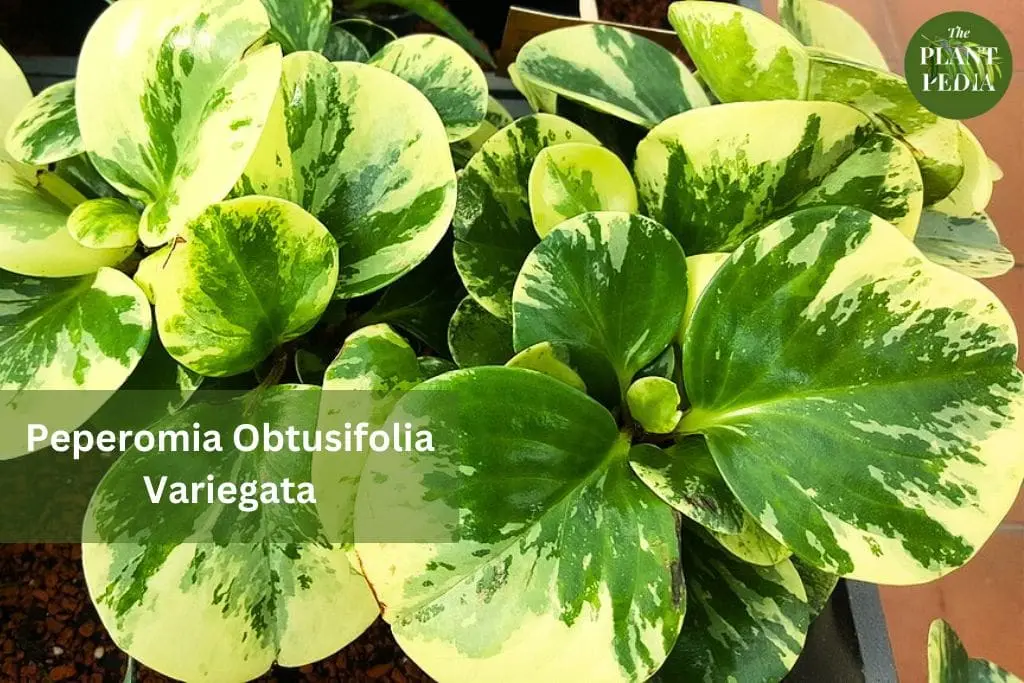Indoor plants have always held a special place in the hearts of plant enthusiasts and interior decorators alike.
One such captivating and versatile houseplant is the Peperomia Obtusifolia Variegata (Variegated Baby Rubber Plant).
With its unique variegated foliage and easy-care nature, this plant has become a favorite among both beginners and seasoned plant lovers.
In this comprehensive guide, we’ll dive deep into the world of Peperomia Obtusifolia Variegata, exploring its origins, care requirements, propagation methods, and the aesthetic value it adds to indoor spaces.
Origins and Taxonomy of Peperomia Obtusifolia Variegata
The origins of Peperomia obtusifolia variegata are unknown, but it is thought to have originated in the Amazon rainforest of South America.
The plant is a cultivar, which means that it is a cultivated variety of the species Peperomia obtusifolia. Cultivars are created by selective breeding to produce plants with desirable characteristics, such as variegated leaves.
The scientific name for Peperomia obtusifolia variegata is Peperomia obtusifolia ‘Variegata’.
The genus name, Peperomia, comes from the Greek words peperi, meaning “pepper”, and omia, meaning “resembling”. This is because the leaves of some Peperomia species are pepper-scented.
The species name, obtusifolia, means “blunt-leaved”. This refers to the shape of the leaves, which are oval and have a blunt tip.
The taxonomy of Peperomia obtusifolia variegata is as follows:
- Kingdom: Plantae
- Phylum: Tracheophyta
- Class: Magnoliopsida
- Order: Piperales
- Family: Piperaceae
- Genus: Peperomia
- Species: obtusifolia
- Cultivar: ‘Variegata’
Read: Peperomia Obtusifolia Propagation in Soil From Leaf & Stem.

Distinctive Features
The allure of peperomia obtusifolia variegata lies primarily in its leaves. These leaves are characterized by their plump, succulent-like appearance, which not only adds to their aesthetic appeal but also contributes to the plant’s resilience.
The leaves have a unique rounded shape with gently pointed tips, giving them an almost heart-like contour.
Their smooth, glossy texture adds an element of sophistication to their visual appeal, making them a favorite subject of plant enthusiasts and photographers alike.
The variegation, the hallmark of this cultivar, is a result of the intricate interplay between chlorophyll and other pigments within the leaf cells.
The green portions of the leaves contain chlorophyll, the pigment responsible for photosynthesis, while the cream-colored areas result from reduced chlorophyll production.
This intriguing phenomenon not only creates a feast for the eyes but also reflects the plant’s ability to adapt and express itself in diverse ways.
Caring for Peperomia Obtusifolia Variegata
Caring for peperomia obtusifolia variegata involves understanding and catering to its specific requirements.
A well-tailored care routine ensures the plant’s health and longevity, allowing it to thrive and continue gracing your living space with its beauty.
Light Requirements:
Finding the right balance of light is crucial for the well-being of your peperomia obtusifolia variegata.
While it appreciates bright, indirect light, direct sunlight can be detrimental to its delicate leaves, causing sunburn. Placing the plant near a north-facing window or providing filtered light is ideal.
Watering and Humidity:
Watering should be done with care to prevent overwatering, which can lead to root rot. Allow the top inch of the soil to dry out before watering again.
Humidity is essential, especially if you’re in a dry climate. Placing a tray of water near the plant or using a humidity tray can help maintain the moisture levels it craves.
Temperature Tolerance:
Peperomia obtusifolia variegata thrives in temperatures between 65°F to 80°F (18°C to 27°C).
It’s important to protect the plant from sudden temperature fluctuations and drafts, as they can stress the plant.
Soil Mix and Repotting:
Using a well-draining potting mix that allows excess water to escape is essential. A mix of peat, perlite, and bark can work well.
Repot the plant every 2-3 years to provide fresh nutrients and ample space for growth.
Fertilization:
During the growing season (spring and summer), feed the plant with a balanced, diluted liquid fertilizer every 4-6 weeks.
This provides the essential nutrients the plant needs to support its variegated foliage and overall growth. Reduce feeding during the dormant season to avoid over-fertilization.
Propagating
The joy of propagating plants is akin to nurturing life itself. Peperomia obtusifolia variegata can be propagated through various methods, each with its own level of success and satisfaction.
Leaf Cuttings:
Propagating through leaf cuttings involves selecting a healthy leaf, preferably one with a stem attached. Gently remove the leaf, taking care not to damage it, and allow it to callus for a day.
Plant the calloused end in a well-draining rooting medium and mist it occasionally to maintain humidity.
With time and patience, tiny roots will emerge from the stem node, leading to the formation of a new plant.
Stem Cuttings:
Stem cuttings are another effective method of propagation. Select a healthy stem tip with a few leaves and place it in a rooting medium. Ensure that at least one leaf node is below the soil.
Keep the cutting in a humid environment to promote root development. With adequate care, the cutting will develop roots and eventually grow into a new plant.
Pest and Disease Management
While peperomia obtusifolia variegata is relatively hardy, it’s not impervious to pests and diseases. Common indoor plant pests such as spider mites, mealybugs, and aphids can still pose a threat.
Regularly inspect the plant’s foliage, both front and back, to catch any infestations early. Quarantine new plants before introducing them to your collection to prevent potential infestations from spreading.
If you notice any pests, you can use neem oil, insecticidal soap, or other natural remedies to control them.
Leveraging Aesthetic Appeal: Using Peperomia Obtusifolia Variegata in Interior Design
Peperomia obtusifolia variegata transcends its role as a mere houseplant; it becomes an element of interior design, enhancing the aesthetics of any space it graces.
Its compact size makes it suitable for various settings, from apartments with limited space to sprawling living rooms.
The variegated foliage acts as a natural focal point, drawing the eye and infusing a sense of vibrancy into the environment.
Its color palette, a symphony of green and cream, complements a wide range of interior design styles.
Whether your space features a minimalist, modern aesthetic or a more eclectic, bohemian vibe, peperomia obtusifolia variegata can seamlessly blend in or stand out, depending on your design vision.
Related FAQs:
Is Peperomia obtusifolia variegata toxic to pets?
No, this plant is non-toxic to both cats and dogs, making it a safe choice for households with furry companions.
Why are the leaves losing their variegation?
Several factors, including insufficient light, improper watering, or nutrient deficiencies, can lead to a loss of variegation.
Ensuring that the plant receives adequate light and proper care can help maintain its distinctive appearance.
How often should I water my Peperomia obtusifolia variegata?
The frequency of watering depends on various factors, including the season, humidity levels, and the type of potting mix.
As a general guideline, water the plant when the top inch of the soil feels dry to the touch.
Be sure to adjust your watering routine during the plant’s dormant period, typically in the fall and winter, when it requires less water.
Can I place my Peperomia obtusifolia variegata outdoors?
While peperomia obtusifolia variegata is primarily an indoor plant, it can benefit from spending some time outdoors during the warmer months.
However, it’s important to gradually acclimate the plant to outdoor conditions to prevent shock.
Place it in a shaded or partially shaded spot to protect it from direct sunlight, wind, and extreme temperature changes.
Why are the leaves of my Peperomia obtusifolia variegata turning yellow?
Yellowing leaves can be a sign of overwatering, underwatering, or nutrient deficiencies. Assess the moisture level of the soil and adjust your watering accordingly.
Additionally, consider the plant’s position—too much direct sunlight can cause sunburn and yellowing.
If you’ve ruled out these factors, a lack of essential nutrients might be the cause, and fertilizing the plant can help rectify this issue.
Is it normal for my Peperomia obtusifolia variegata to shed leaves?
It’s natural for peperomia obtusifolia variegata to shed a few older leaves as new growth emerges.
However, if you notice excessive leaf drop, it could indicate stress due to factors like inconsistent watering, abrupt changes in lighting conditions, or pests.
Carefully assess the plant’s environment and adjust its care routine to minimize stress.
How can I promote more vibrant variegation in my plant’s leaves?
Variegation can become less prominent if the plant is receiving inadequate light.
To promote vibrant variegation, ensure your peperomia obtusifolia variegata is receiving the appropriate amount of bright, indirect light.
Additionally, maintain consistent care practices and provide the plant with balanced nutrition through proper fertilization.
Can I prune my Peperomia obtusifolia variegata to control its growth?
Yes, pruning is a viable method to control the growth and shape of your peperomia obtusifolia variegata.
Prune back leggy stems or remove any damaged or yellowing leaves.
Pruning not only helps maintain the plant’s aesthetics but also encourages new growth and a bushier appearance.
What type of container is best for my Peperomia obtusifolia variegata?
Choose a container with drainage holes to prevent water from accumulating at the bottom, which can lead to root rot.
A well-draining potting mix combined with a suitable container promotes healthy root growth and overall plant health.
Can I use Peperomia obtusifolia variegata in terrariums or enclosed environments?
While peperomia obtusifolia variegata can thrive in humid conditions, enclosed terrariums might create excessive moisture levels that could lead to fungal issues.
If you’re set on using it in a terrarium, ensure proper air circulation and monitor moisture levels to prevent potential problems.
How do I encourage my Peperomia obtusifolia variegata to flower?
Peperomia obtusifolia variegata does produce small, inconspicuous flower spikes, but they are not the main attraction of the plant.
To encourage flowering, provide a consistent care routine, including appropriate light and feeding.
However, be aware that the flowers are relatively modest and might not be the plant’s standout feature.
Conclusion
Peperomia obtusifolia variegata, with its mesmerizing leaves and adaptable nature, serves as a living testament to the wonders of the plant world.
As you nurture this plant and witness its growth, you become part of its journey—one that spans continents and connects generations.
Through understanding its origins, caring for its needs, and integrating it into your living space, you not only enrich your surroundings but also foster a deeper appreciation for the intricate beauty of the natural world.
As you marvel at the interplay of light on its variegated leaves, you’ll find yourself captivated by the elegance and resilience of peperomia obtusifolia variegata.
